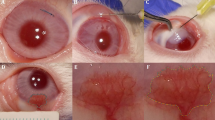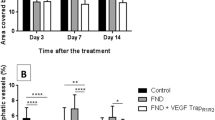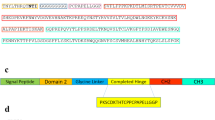Abstract
Corneal neovascularization, which occurs in many pathologic states of the cornea, reduces the visual acuity. Recently, we found that the extracellular region of brain-specific angiogenesis inhibitor 1 (BAI1-ECR) has antiproliferative activity through functional blocking of αvβ5 integrin in endothelial cells. In this study, we investigated the effects of lipid-mediated subconjunctival injection of the BAI1-ECR gene on corneal angiogenesis induced by epithelial debridement by heptanol in the rabbit. When a pEGFP-BAI1-ECR plasmid was given subconjunctivally 1 week after epithelial debridement, green fluorescence was detected in the corneal stroma with expression persisting for 7 days. To test the effect of BAI1-ECR on neovascularization, rabbits were injected with the BAI1-ECR gene or empty vector two or three times at 1-week intervals beginning 1 week after debridement. When measured with biomicroscopy at 1 or 2 weeks after two weekly injections, BAI1-delivered eyes had significantly less neovascularized corneal area than vector-injected ones in both time periods. Similar microscopic results were obtained after three weekly injections of BAI1-ECR. In quantitative histological examination, the BAI1-receiving eyes showed significantly less neovascular area and number of vessels than vector-injected ones. Also, after two weekly injections, BAI1-delivered eyes had decreased neovascularized corneal area equivalent to that of anti-VEGF antibody-injected ones. These results indicate that BAI1-ECR gene delivery effectively reduces experimental corneal neovascularization and suggest that the BAI1-ECR protein can be used as an angiogenesis suppressor in the eye.
This is a preview of subscription content, access via your institution
Access options
Subscribe to this journal
Receive 12 print issues and online access
$259.00 per year
only $21.58 per issue
Buy this article
- Purchase on Springer Link
- Instant access to full article PDF
Prices may be subject to local taxes which are calculated during checkout





Similar content being viewed by others
References
Chang JH, Gabison EE, Kato T, Azar DT . Corneal neovascularization. Curr Opin Ophthalmol 2001; 12: 242–249.
Folkman J . Angiogenesis in cancer, vascular, rheumatoid and other disease. Nat Med 1995; 1: 27–31.
Duenas Z et al. Inhibition of rat corneal angiogenesis by 16-kDa prolactin and by endogenous prolactin-like molecules. Invest Ophthalmol Vis Sci 1999; 40: 2498–2505.
Auerbach W, Auerbach R . Angiogenesis inhibition: a review. Pharmacol Ther 1994; 63: 265–311.
Moses MA, Sudhalter J, Langer R . Identification of an inhibitor of neovascularization from cartilage. Science 1990; 248: 1408–1410.
Casey R, Li WW . Factors controlling ocular angiogenensis. Am J Ophthalmol 1997; 124: 521–529.
Lin HC et al. Endostatin localization in the cornea. Invest Ophthalmol Vis Sci 2000; 41: S832.
Ambati BK et al. Angiostatin inhibits and regresses corneal neovascularization. Arch Ophthalmol 2002; 120: 1063–1068.
Wu PC et al. Inhibition of experimental angiogenesis of cornea by somatostatin. Graefes Arch Clin Exp Ophthalmol 2003; 241: 63–69.
Shafiee A et al. Inhibition of retinal angiogenesis by peptides derived from thrombospondin-1. Invest Ophthalmol Vis Sci 2000; 41: 2378–2388.
Bainbridge JW, Mistry AR, Thrasher AJ, Ali RR . Gene therapy for ocular angiogenesis. Clin Sci (London) 2003; 104: 561–575.
Yu WZ et al. Gene transfer of kringle 5 of plasminogen by electroporation inhibits corneal neovascularization. Ophthalmic Res 2003; 35: 239–246.
Nishimori H et al. A novel brain-specific p53-target gene, BAI1, containing thrombospondin type 1 repeats inhibits experimental angiogenesis. Oncogene 1997; 15: 2145–2150.
Koh JT et al. Characterization of mouse brain-specific angiogenesis inhibitor 1 (BAI1) and phytanoyl-CoA alpha-hydroxylase-associated protein 1, a novel BAI1-binding protein. Mol Brain Res 2001; 87: 223–237.
Kee HJ et al. Expression of brain-specific angiogenesis inhibitor 2 (BAI2) in normal and ischemic brain: involvement of BAI2 in the ischemia-induced brain angiogenesis. J Cereb Blood Flow Metab 2002; 22: 1052–1067.
Koh JT et al. Extracellular fragment of brain-specific angiogenesis inhibitor 1 suppresses endothelial cell proliferation by blocking αvβ5 integrin. Exp Cell Res 2004; 294: 172–184.
Ko HM et al. Nuclear factor kappaB dependency of platelet-activating factor-induced angiogenesis. Cancer Res 2002; 62: 1809–1814.
Benelli U, Ross JR, Nardi M, Klintworth GK . Corneal neovascularization induced by xenografts or chemical cautery. Inhibition by cyclosporin A. Invest Ophthalmol Vis Sci 1997; 38: 274–282.
Joussen AM et al. Inhibition of inflammatory corneal aniogenensis by TNP-470. Invest Ophthalmol Vis Sci 2001; 42: 2510–2516.
Phillips K et al. Effect of prednisolone and medroxyprogesterone on corneal wound healing, ulceration, and neovascularization. Arch Ophthalmol 1983; 101: 640–643.
Hayness WL, Proia AD, Klintworth GK . Effect of inhibitors of arachidonic acid metabolism on corneal neovascularization in the rat. Invest Ophthalmol Vis Sci 1989; 30: 1588–1593.
Kruse FE et al. Thalidomide inhibits corneal angiogenesis induced by vascular endothelial growth factor. Graefes Arch Clin Exp Ophthalmol 1998; 236: 461–466.
Joussen AM, Kruse FE, Volcker HE, Kirchhof B . Topical application of methotrexate for inhibition of corneal angiogenesis. Graefes Arch Clin Exp Ophthalmol 1999; 237: 920–927.
Kobayashi N et al. Suppression of corneal neovascularization by culture supernatant of human amniotic cells. Cornea 2002; 21: 62–67.
Gorrin-Rivas MJ et al. Mouse macrophage metalloelastase gene transfer into a murine melanoma suppresses primary tumor growth by halting angiogenesis. Clin Cancer Res 2000; 6: 1647–1654.
Matsuda KM et al. A novel strategy for tumor angiogenesis-targeted gene therapy: generation of angiostatin from endogenous plasminigen by protease gene transfer. Cancer Gene Ther 2000; 7: 589–596.
Stechschulte S et al. Rapid ocular angiogenic control via naked DNA delivery to cornea. Invest Ophthalmol Vis Sci 2001; 42: 1975–1979.
Plate KH . Mechanisms of angiogenesis in the brain. J Neuropathol Exp Neurol 1999; 58: 313–320.
Van Meir EG et al. Release of an inhibitor of angiogenesis upon induction of wild type p53 expression in glioblastoma cells. Nat Genet 1994; 8: 171–176.
Brooks PC et al. Integrin alphav beta3 antagonists promote tumor regression by inducing apoptosis of angiogenic blood vessels. Cell 1994; 79: 1157–1164.
Friedlander M et al. Definition of two angiogenic pathways by distinct alphav integrins. Science 1995; 270: 1500–1502.
Friedlander M et al. Involvement of integrins alphav beta3 and alphav beta5 in ocular neovascular diseases. Proc Natl Acad Sci USA 1996; 93: 9764–9769.
Erdreich-Epstein A et al. Integrins alpha(v)beta3 and alpha(v)beta5 are expressed by endothelium of high-risk neuroblastoma and their inhibition is associated with increased endogenous ceramide. Cancer Res 2001; 60: 712–721.
Kook H et al. Nitric oxide-dependent cytoskeletal changes and inhibition of endothelial cell migration contribute to the suppression of angiogenesis by RAD50 gene transfer. FEBS Lett 2003; 553: 56–62.
Acknowledgements
We thank Song Eun Lee for assisance with immunohistochemistry and Jennifer Macke for assistance in preparing the text. This work was supported by the Korea Science & Engineering Foundation through the Medical Research Center for Gene Regulation (R13-2002-013-02000-0) at Chonnam National University.
Author information
Authors and Affiliations
Rights and permissions
About this article
Cite this article
Yoon, K., Ahn, K., Lee, J. et al. Lipid-mediated delivery of brain-specific angiogenesis inhibitor 1 gene reduces corneal neovascularization in an in vivo rabbit model. Gene Ther 12, 617–624 (2005). https://doi.org/10.1038/sj.gt.3302442
Received:
Accepted:
Published:
Issue Date:
DOI: https://doi.org/10.1038/sj.gt.3302442
Keywords
This article is cited by
-
Therapeutic Strategies for Corneal Wound Angiogenesis
Current Pathobiology Reports (2020)
-
Anti-neovascular effect of chondrocyte-derived extracellular matrix on corneal alkaline burns in rabbits
Graefe's Archive for Clinical and Experimental Ophthalmology (2014)
-
A proprotein convertase/MMP-14 proteolytic cascade releases a novel 40 kDa vasculostatin from tumor suppressor BAI1
Oncogene (2012)
-
Emerging roles for the BAI1 protein family in the regulation of phagocytosis, synaptogenesis, neurovasculature, and tumor development
Journal of Molecular Medicine (2011)
-
Subconjunctival gene delivery of the transcription factor GA-binding protein delays corneal neovascularization in a mouse model
Gene Therapy (2009)



